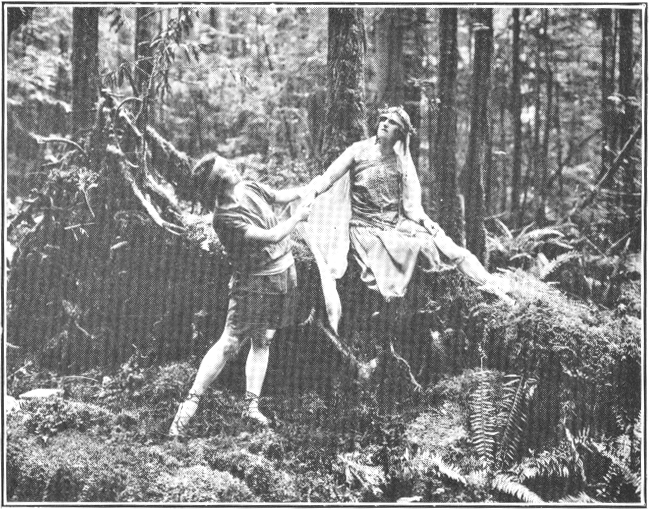May 25, 1924
 The second spring show, an Oriental pantomime, The Shepherd in the Distance by Holland Hudson, was directed by Mrs. Sandall.
The second spring show, an Oriental pantomime, The Shepherd in the Distance by Holland Hudson, was directed by Mrs. Sandall.
The all-female cast included Edith Knudson, who danced, Aleda Tarbill, a beggar, Peggy Wentworth, a shepherd, and Florence McComb, a goat. This Oriental pantomime drew an audience of about 200 Mountaineers.
"The sunshine filtered softly through the great trees upon the smooth earth stage, whose footlights were green sword ferns. The stage was surrounded by fallen moss-covered trunks, and was high canopied by Nature's lacework of fir and hemlock boughs. On the left a winding path led up the steep, richly verdured hill. Near the top, a green screen had been cunningly devised of ferns and cedar boughs, so that it could be lowered when needful for the display of distant dramatic scenes . . . Here and there about the stage were mounds overlaid with moss and soft, clinging draperies of harmonious color. "Such was the picture that greeted the expectant guests as they came happily down the hill from the Cabin, enticed thither by the Snake-charmer and her attendant slave. At his mistress' bidding, the slave approached each mound in turn, lifted the draperies and as if my magic discovered, group by group, the performers, picturesquely posed like a silent human orchestra awaiting the signal of its leader. The last to be discovered was 'The Maker of Sounds,' whose want was to guide the play . . ."
"The simple plot of the drama is now read aloud. The scene is laid in the garden of the Wazir, the guardian of the beautiful Princess, who at an opportune time escapes with her four maidens to the hill. There she meets the shepherd attended by his goat, which dances to the music of his flute . . . The finale is a beautiful tableau in the distance, showing again a pretty love scene, while the goat plays the flute."
".. . Each scene was an integral part of this forest wonderland, and when all was over, the several groups of players returned to their initial places, were covered once more by soft draperies, and the woods seemed again all untenanted. The dream was over" (Ella M. Ehinger, The Mountaineers, 1924)
"At this time Bill Darling's theatrical talents began to blossom. He was the one who thought of the ingenious plan of hiding the players under green mounds, and retiring them the same way so that at the finish the stage looked just as it did at the beginning. He also designed the Nubian slave's handsome fan. The masks were modeled by Mabel Furry. They were very human and realistic, especially that of the beggar." (Elizabeth Kirkwood, The Mountaineers, 1930)
